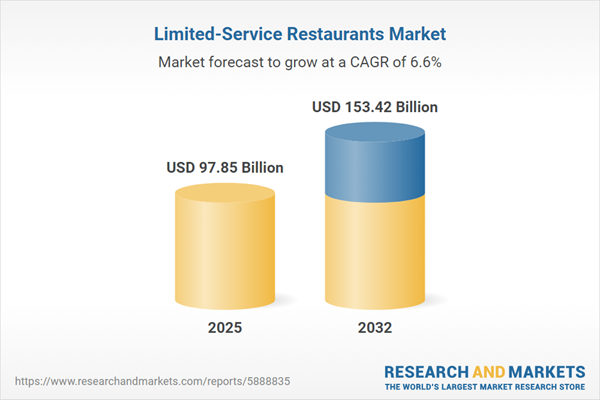Speak directly to the analyst to clarify any post sales queries you may have.
Senior executives in the foodservice industry increasingly view the limited-service restaurants market as a fertile ground for expansion, leveraging technology and operational agility to capitalize on evolving consumer demands.
Market Snapshot: Limited-Service Restaurants Market
The limited-service restaurants market is advancing globally as operators adopt digital ordering and optimize workflows to deliver faster, more consistent service. Brands in this sector are prioritizing customer experiences by integrating new technologies to enhance service efficiency and stay ahead of changing trends. Restaurant models are evolving, with increased emphasis on drive-thru and online ordering, extending their reach and engagement across communities. The market is expanding in both developed and emerging economies, driven by continuous operational enhancements and an agile response to local preferences. Leading stakeholders anchor their competitive strategies in digital transformation and adaptive execution, positioning themselves to respond quickly to consumer shifts and maintain market leadership.
Scope & Segmentation in the Limited-Service Restaurants Market
- Operator Model: Company-owned outlets, franchised businesses, and joint ventures enable rapid market penetration and tailored localization for regional success.
- Service Format: Cafeteria-style concepts, fast casual dining, drive-thru facilities, and self-service kiosks foster operational efficiency while engaging diverse customer bases.
- Distribution Channel: Dine-in, takeaway, drive-thru, and digital ordering platforms expand options to accommodate changing consumer preferences and maximize reach.
- Price Tier: Midscale, value-driven, and premium options facilitate customer segmentation and enable targeted loyalty initiatives based on spending patterns.
- Meal Type: Breakfast, lunch, dinner, snacks, and desserts offer operators continuous sales opportunities throughout the day and enhance menu diversification.
- Cuisine Type: A span from Asian cuisines like Chinese, Indian, Japanese, and Thai to global staples such as burgers, pizza, coffee, tea, and sandwiches supports both multicultural appeal and regional menu adaptation.
- Geographic Coverage: The market stretches across the Americas, Europe, Middle East and Africa, and Asia-Pacific, where players adapt strategies to variations in regulation and local consumer expectations.
- Company Coverage: Major industry leaders—including McDonald’s Corporation, Starbucks Corporation, Restaurant Brands International Inc., Yum! Brands, Chick-fil-A, The Wendy’s Company, Chipotle Mexican Grill, Domino’s Pizza, Papa John’s International, and Jack in the Box Inc.—establish benchmarks for strategy and operational performance within the sector.
Key Takeaways for Senior Leaders
- Mobile ordering technologies and automation enhance order accuracy, standardize quality, and reduce wait times, supporting brand dependability across locations.
- Sustainability initiatives in menu design and packaging promote regulatory alignment and foster trust among investors and the broader stakeholder community.
- Strengthened supply chain agility and focused menu strategies ensure operational resilience, enabling organizations to withstand sudden disruptions and maintain a reliable customer experience.
- Well-developed compliance practices ease international and local expansion, simplifying the process of conforming to various regulatory requirements.
- Region-specific digital solutions assist management of complex regulations and help drive quality improvements, particularly important for multinational expansion.
- Business innovation through new models, including ghost kitchens and blended formats, enables brands to access untapped markets and engage with emerging demographics.
Tariff Impact on Sourcing and Supply Chain
Recent changes in tariffs affecting agricultural inputs, kitchen equipment, and packaging have increased sourcing costs for limited-service restaurant operators. In response, leading companies diversify their supplier networks, emphasize local and seasonal sourcing, and refine logistics strategies. The use of advanced analytics in procurement allows for better prediction of disruptions and facilitates quick, evidence-based decision-making. Maintaining supply chain continuity and managing cost pressures remain priorities as international trade conditions fluctuate.
Methodology & Data Sources
This analysis draws on executive interviews, proprietary digital ordering data, and established market research. All trends and key observations are verified through independent checks, quantitative modeling, and sentiment analysis to maintain accuracy and relevance within the foodservice industry.
Why This Report Matters
- Provides actionable frameworks and performance benchmarks for guiding digital transformation and operational excellence in the limited-service restaurants market.
- Equips senior decision-makers with the tools to optimize global and regional supply chains while selecting digital strategies that address distinct local challenges and opportunities.
- Offers strategic insight to support proactive management of regulatory change and the ongoing evolution of competitive dynamics within the sector.
Conclusion
Ongoing innovation and deeper digital integration are shaping the next phase for limited-service restaurants. This report gives executives practical guidance to cultivate adaptable, resilient, and growth-centric operations.
Additional Product Information:
- Purchase of this report includes 1 year online access with quarterly updates.
- This report can be updated on request. Please contact our Customer Experience team using the Ask a Question widget on our website.
Table of Contents
3. Executive Summary
4. Market Overview
7. Cumulative Impact of Artificial Intelligence 2025
Companies Mentioned
The companies profiled in this Limited-Service Restaurants market report include:- McDonald's Corporation
- Starbucks Corporation
- Restaurant Brands International Inc.
- Yum! Brands, Inc.
- Chick-fil-A, Inc.
- The Wendy's Company
- Chipotle Mexican Grill, Inc.
- Domino's Pizza, Inc.
- Papa John's International, Inc.
- Jack in the Box Inc.
Table Information
| Report Attribute | Details |
|---|---|
| No. of Pages | 191 |
| Published | October 2025 |
| Forecast Period | 2025 - 2032 |
| Estimated Market Value ( USD | $ 97.85 Billion |
| Forecasted Market Value ( USD | $ 153.42 Billion |
| Compound Annual Growth Rate | 6.6% |
| Regions Covered | Global |
| No. of Companies Mentioned | 11 |









